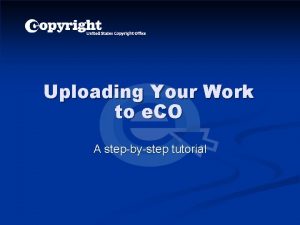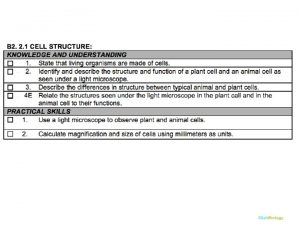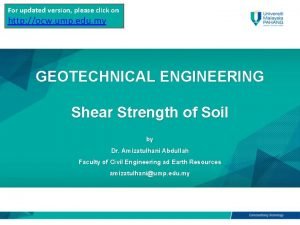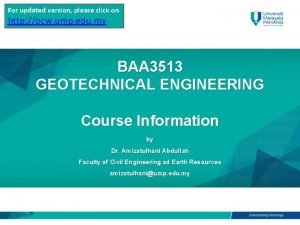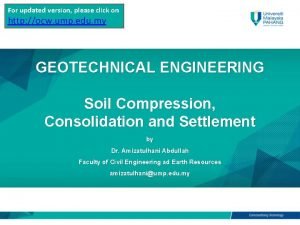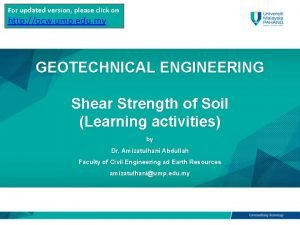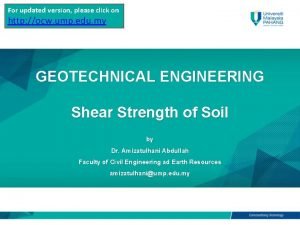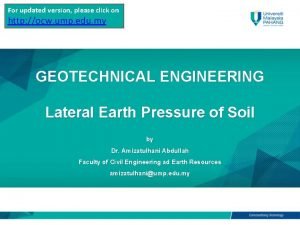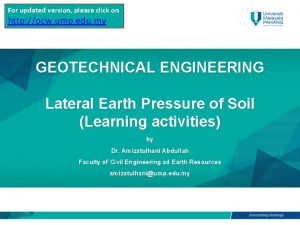For uploaded version please click on this http


















- Slides: 18

For uploaded version, please click on this: http: //ocw. ump. edu. my BTV 2213 Thermodynamics Chapter 2: Problem-Solving Technique by Nasrin Khodapanah Faculty of Engineering Technology nasrin@ump. edu. my Problem Solving Technique BY Nasrin Khodapanah

Chapter Description • Aims • Expected Outcomes • – Develop the concept of property, state, equilibrium, process and path in thermodynamics – Discuss thermodynamics problem-solving technique – Evaluate appropriate system boundaries for analyzing a variety of thermodynamics components and system – – – Students able to understand the concept of property, state, equilibrium, process and path Students able to extend the basic concepts of thermodynamics to problem solving technique Students able to understand system boundaries for analyzing a variety of thermodynamics components and system References – Cengel, Y. A and Boles, M. A (2010), ”Thermodynamics: An Engineering Approach(7 th Edition)”, Mc. Graw Hill, New York – Cengel, Y. A (2012): Introduction to Thermodynamics and Heat Transfer, Mc. Graw Hill, New York – Robert Balmer (2011): Thermodynamics, Jaico Publication Problem Solving Technique BY Nasrin Khodapanah

Thermodynamics problem-solving technique Problem Solving Technique BY Nasrin Khodapanah

System and Control volume Problem Solving Technique BY Nasrin Khodapanah

Classification of thermodynamics systems Problem Solving Technique BY Nasrin Khodapanah

Classification of thermodynamics systems Mass NO GAS 2 kg 1 m 3 GAS 2 kg 3 m = const. E = const. Energy CLOSED System with Moving Boundary NO ISOLATED System Mass YES Energy OPEN System YES Problem Solving Technique BY Nasrin Khodapanah

Classification of thermodynamics systems BOUNDARY around of OPEN System is CONTROL SURFACE /CONTROL VOLUME. Real Boundary In Out Imaginary Boundary Mass and Energy can pass through Control Volume Boundaries Problem Solving Technique BY Nasrin Khodapanah

Thermodynamics property Property: any measurable/observable characteristics of the substance when the system is in equilibrium state. • Intensive property: Those properties do not depend on the mass, such as temperature, pressure and density. • Extensive property: Those properties depend on the mass, such as volume, total energy and etc. Problem Solving Technique BY Nasrin Khodapanah

State & Equilibrium • Those properties of system describe the condition of the system is system STATE m = 2 kg T 1 = 25 ºC V 1 = 1 m 3 STATE 1 STATE 2 Problem Solving Technique BY Nasrin Khodapanah

State & Equilibrium EQUILIBRIUM (State of Balance) • Thermal Equilibrium : NO Temperature Gradient throughout the system. • Mechanical Equilibrium : NO Pressure Gradient throughout the system. • Phase Equilibrium : System having more than 1 phase. Mass of each phase is in equilibrium. • Chemical Equilibrium : Chemical composition is constant NO reaction occurs. Problem Solving Technique BY Nasrin Khodapanah

Path and Process Property B Quasi-Static State 2 State 1 State 2 t=t 1 t=0 Non-Quasi-Static State 1 Path Property A t=t 2 t t 2 < t 1 t=0 Problem Solving Technique BY Nasrin Khodapanah

Path and Process Problem Solving Technique BY Nasrin Khodapanah

Reversible / Irreversible Process Problem Solving Technique BY Nasrin Khodapanah

Appropriate system boundaries to analyze a variety of thermodynamics components and system TUTORIAL CHAPTER 1 Problem Solving Technique BY Nasrin Khodapanah

Exercise#1 • Express a pressure of 75. 2 k. Pa as a gage pressure. The local atmospheric pressure is 103. 4 k. Pa. Notice that the result is negative. This can also be read “ 28. 2 k. Pa below atmospheric pressure” or “ 28. 2 k. Pa vacuum. ” Problem Solving Technique BY Nasrin Khodapanah

Exercise#2 • Express a gage pressure of – 42. 7 k. Pa as an absolute pressure. Because no value was given for the atmospheric pressure, we will use patm=101 k. Pa: Problem Solving Technique BY Nasrin Khodapanah

Conclusion of The Chapter 2 Problem Solving Technique BY Nasrin Khodapanah

1. Hae-Geon Lee (2012) Introduction. Materials Thermodynamics 2. Huang, Biao, Yutong Qi, and A. K. M. Murshed. "First Principle Modelling for Chemical Processes. " Dynamic Modelling and Predictive Control in Solid Oxide Fuel Cells: First Principle and Data-Based Approaches: 11 -29. 3. Kanoglu, Mehmet, Ibrahim Dincer, and Yunus A. Cengel. "Exergy for better environment and sustainability. " Environment, Development and Sustainability 11. 5 (2009): 971988. Problem Solving Technique BY Nasrin Khodapanah
 How to delete an uploaded file on managebac
How to delete an uploaded file on managebac Click clever click safe
Click clever click safe Clever click
Clever click E safety
E safety Click clever click safe
Click clever click safe Click the button below
Click the button below Nobody said anything raymond carver
Nobody said anything raymond carver Siat.ung.ac.id krs
Siat.ung.ac.id krs Http //mbs.meb.gov.tr/ http //www.alantercihleri.com
Http //mbs.meb.gov.tr/ http //www.alantercihleri.com Humanitr
Humanitr Datorkunskap för nybörjare
Datorkunskap för nybörjare Fredsgudinna pax
Fredsgudinna pax Nationell inriktning för artificiell intelligens
Nationell inriktning för artificiell intelligens Rita perspektiv
Rita perspektiv Ministerstyre för och nackdelar
Ministerstyre för och nackdelar Bästa kameran för astrofoto
Bästa kameran för astrofoto Sju principer för tillitsbaserad styrning
Sju principer för tillitsbaserad styrning Nyckelkompetenser för livslångt lärande
Nyckelkompetenser för livslångt lärande Lyrik
Lyrik
